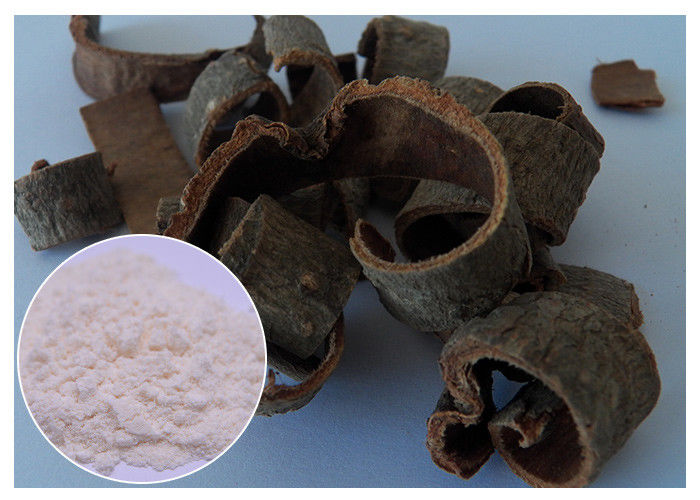Magnolia Bark Antifungal Plant Extracts Protecting Liver CAS 528 43 8 HPLC Test Method
Basic Info of Magnolia Bark Extract:
| Product Name |
Magnolia Bark Extract |
| Latin Name |
Magnolia officinalis Rehd.et Wils |
| Used Part |
Bark |
| Solvent Used |
Ethanol & Water |
| Active Ingredient 1 |
Magnolol+Honokiol |
| Specification |
50%, 90%, 95% |
| Active Ingredient 2 |
Magnolol |
| Specification |
50%, 90%, 98% |
| Active Ingredient 3 |
Honokiol |
| Specification |
50%, 90%, 98% |
| Test Method |
HPLC |
| Appearance |
Yellow to white fine powder |
| Packing size |
25kg/drum, 1kg/bag |
| Other Status |
Natural Ingredient, No synthetic part.
Non-GMO, Non-IR, Non-ETO, BSE Free.
|
| Shelf Life |
2 years |
| Country of Origin |
China |
| Sample Status |
10g free sample is available |

Plant Source:
Magnolia bark It refers to the dried bark of trunk, root, and branch of Magnolia officinalis Rehd. et Wils. or Magnolia officinalis Rehd. et Wils. var. biloba Rehd. et Wils., plants in the family of Magnoliaceae. Also, other names include cortex magnoliae officinalis and cortex magnoliae. Root and branch barks are placed in the shade to dry. This is a deciduous tree, 5 to 15 meters in height. Barks are purple-brown. Twigs have fine hairs when young but glabrous when old. Buds in winter are thick, conical, and with bud scales densely covered with pale brown hair. Leaves are alternate, elliptic-obovate, 35 to 45cm long, and 12 to 20cm wide. Flowers, blooming along with leaves, grow solitarily on the top of branch, cup-shaped, white, fragrant, and 15cm in diameter. Aggregate fruit is oblong ovate, 9 to 12cm long and 5 to 6.5cm in diameter. Carpel, woody when mature, is tightly packed and with curved tip on the top. Seeds are triangular-obovate and with red testa. Its flowering period is from April to May and fruit period from September to October.
Magnolia officinalis, eucommia and phellodendron are called “three wood” herbs, which are known for their three medicinal parts of dried barks of trunk, branch, and root. And magnolia tree bark is widely used for a variety of diseases. According to related studies, currently there are more than 200 Chinese patent drugs that are based on this herb.
Magnolol and Honokiol:
Magnolol is an organic compound that is classified as lignan. It is a bioactive compound found in the bark of the Houpu magnolia (Magnolia officinalis) or in M. grandiflora.
Honokiol is a lignan isolated from the bark, seed cones, and leaves of trees belonging to the genus Magnolia. It has been identified as one the chemical compounds in some traditional eastern herbal medicines along with magnolol.
Applications of Magnolia Bark Extract:
Pharmaceutical:
Sedative for central nervous system
Anti-inflammation
Anti-Anaphylaxis
Anti-Diabetic complications
Anti-bacterial
Anti-tumor/Anti-cancer
Anti-depression
Anti-oxidant
Anti-caries
Prevention of oral diseases
Dietary Supplement:
Be good for stomach
Sedative for central nervous system
Prevention of oral diseases
Liver Protection
Cardiovascular protetion
Anti-inflammation
Anti-Anaphylaxis
Anti-Diabetic complications
Antibacterial
Anti-tumor
Anti depression
Anti-oxidant
Anti-caries
Cosmetic:
Anti-Oxidation
Anti-inflammation
Weight Loss
Prevention of oral diseases
Used in toothpaste, gum
Magnolia Bark Extract is used by some Brands. (For Reference Only)


 Your message must be between 20-3,000 characters!
Your message must be between 20-3,000 characters! Please check your E-mail!
Please check your E-mail!  Your message must be between 20-3,000 characters!
Your message must be between 20-3,000 characters! Please check your E-mail!
Please check your E-mail! 

